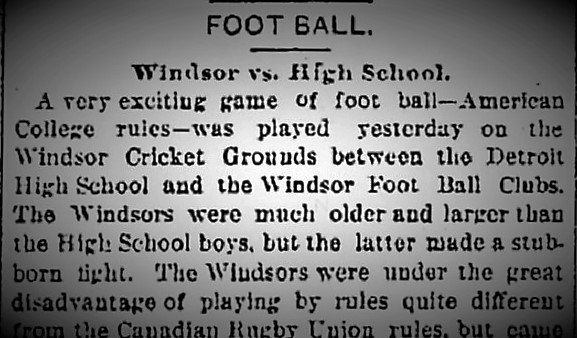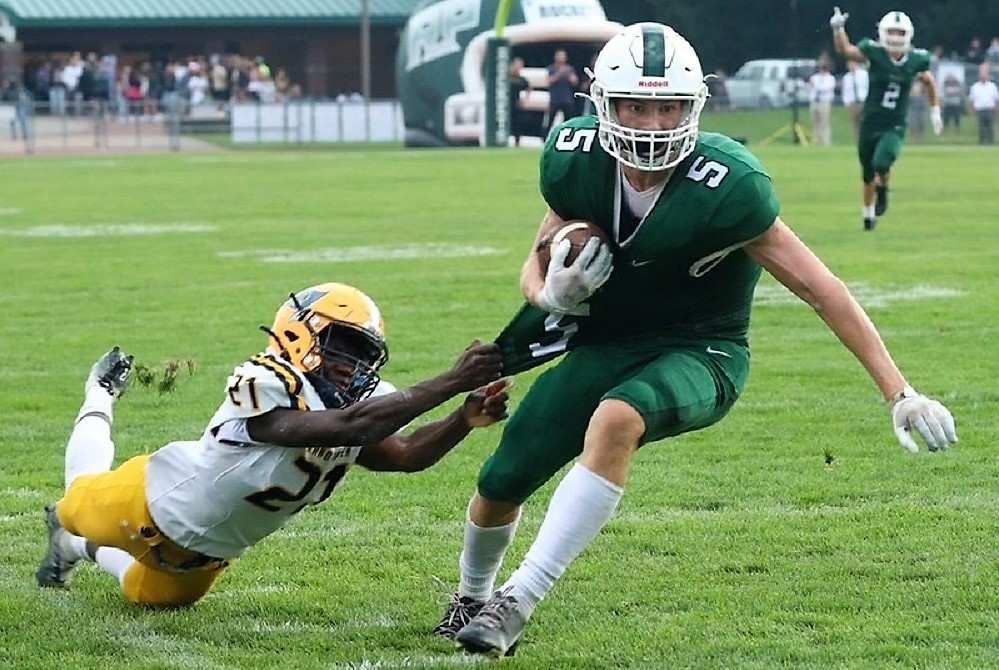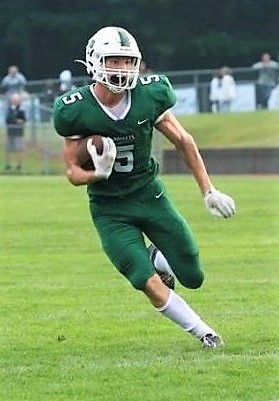
Football Kicks Off Again, 129 Years Later
August 25, 2017
By Ron Pesch
Special for Second Half
Buried in the text on the fourth page of the Saturday, October 27, 1888, Detroit Free Press is a single, concise sentence bearing a minimum amount of detail.
“The Windsor foot ball team will play the Detroit High School team this afternoon at 3.”
To date, this is the earliest account of a Michigan high school playing the game of “foot ball.”
The following day’s paper provides only a few more details. The game was played on the Windsor Cricket Grounds. Despite the great disadvantage of playing under “American Football rules … quite different from the Canadian Rugby Union rules …” the “older and larger” Windsors won the contest, 12-6. Rosters for each squad were provided.
 Under American rules of the time, a touchdown was worth four points, with a conversion kick following a touchdown worth two additional points. At the time, a field goal counted for five points and a safety was worth two. The teams, however, may have agreed to a different scoring system before the contest.
Under American rules of the time, a touchdown was worth four points, with a conversion kick following a touchdown worth two additional points. At the time, a field goal counted for five points and a safety was worth two. The teams, however, may have agreed to a different scoring system before the contest.
Was this the first football game for a Michigan high school? That’s unlikely, but it is certainly among the earliest published accounts involving a prep game in the state.
It’s a fair assumption that foot ball, or some version of the game, was being played in neighborhoods before that time, at least based on the following statement found in the Jackson Citizen Patriot, dated June 18, 1867. Only days before, Dorrance & Goodwin’s, a store on Main Street in Jackson, had placed advertisements in the newspaper’s classifieds noting the pending arrival of this new product.
“Foot Ball – The pastime was inaugurated on our streets yesterday. Three or four balls were kept in motion all day on Main street alone. It affords no little amusement to the little boys, and is certainly a healthy exercise for the larger ones. It’s all right as long as no windows are broken or horses scared. Both calamities were barely escaped scores of times during the day.”
Rutgers and Princeton are credited with playing the first college football game in 1869. A decade later, in 1879, the University of Michigan established a football team.
Detroit High School played a number of games in 1888, besides the Windsor match, including a contest with the Tappen School from the Corktown area of Detroit. Played at the Detroit Athletic Club grounds on the afternoon of Thursday November 15, a final score was not mentioned in the following day’s Free Press.
For those unfamiliar with the sport, an account of the University of Michigan versus Detroit Athletic Club contest that appeared in the November 18 Free Press served as a fine introduction to the game, and the determination behind securing “possession of a leather-covered foot ball.”
“It was very interesting to see one speedy young man, after a desperate struggle in which the spectators fully expected to see him lose an arm or a leg, get away from his captors and start like a deer, with eight or ten of the opposite side in full pursuit. He is overtaken and the leader of the pursuing party springs upon the back of the man with the inflated trophy, bearing him to the ground with a dull thud … It is also an inspiring sight to see a fleet-footed player seize the ball and run at full speed in the direction of the goal of his opponents. Then a wing-footed opponent cuts across to intercept him, makes a flying leap, grasps the fugitive around the neck or waist and both go to grass with a suddenness and velocity that transforms them into human wheels …
 “While one unaccustomed to foot ball will naturally be startled by some of the acrobatic feats, still it is impossible to watch the game for any length of time without a tingling of the blood and holding of the breath. It is most intensely exciting, continuous in action and replete with fine points of play.
“While one unaccustomed to foot ball will naturally be startled by some of the acrobatic feats, still it is impossible to watch the game for any length of time without a tingling of the blood and holding of the breath. It is most intensely exciting, continuous in action and replete with fine points of play.
“It may be explained that the goals in a foot ball game are set at a distance of 330 feet from each other. The goal is made by placing two pieces of scantling twenty feet long upright in the ground, eighteen and one-half feet apart. Another piece runs midway horizontally between the uprights, and the ball must go over the horizontal piece and between the uprights to count a goal. There are eleven men on each side and the object is, of course, to get the ball through the goal of the other. The time of game is an hour and a half each side playing forty-five minutes from each goal, with an intermission of ten minutes between halves.”
A player who ran over an opponent’s goal line, “with the ball and touched it down” was then entitled to “bring the ball in front of the goal and attempt to kick it through”…
Among those playing for the Athletic Club squad that day was “little Hugh Brooks (captain) of the high school team.” Eligibility rules for players would evolve over time.
On Saturday, November 24, Detroit High School squared off for the first of two contests with Ann Arbor High School, this one at the Detroit Athletic Club grounds. Admission to the 2:45 p.m. contests was 25 cents. A crowd of around 300 watched “an exciting illustration of how Rugby foot ball is played. The exhibition by the Ann Arbor boys was considerably better than that of the Detroiters,” noted the Free Press, “the result of that being that Detroit’s banners have been kicked into the dust.”
Ann Arbor returned home with a 12-0 victory.
A second game with Ann Arbor was quickly scheduled.
In between, on Thursday, November 29, the Detroit High School squad played the Athletic Club before a crowd of about 200.
 “While the Athletics won by 12 to 0, still their playing was very loose, probably the result of over confidence. The Athletics will have to rid themselves of this by Saturday or the Albions will make short work of them.”
“While the Athletics won by 12 to 0, still their playing was very loose, probably the result of over confidence. The Athletics will have to rid themselves of this by Saturday or the Albions will make short work of them.”
A large crowd gathered in the drizzling rain in Ann Arbor on Saturday, December 8, for what appears to be the final contest of the 1888 season for the high school teams of Detroit and Ann Arbor.
“It was a fine game. (Captain) Brooks, McGraw and Wisner, for Detroit, and Jewett, Diggert, Dupont, and Rathbone for Ann Arbor, made fine plays for their respective sides.” The result was an 8 to 2 win, and redemption, for the Detroit squad.
Today, 129 years later, “football” has seen wild expansion, numerous rule changes, and huge advancement in equipment worn when compared to those pioneer days of the sport. In 2017, more than 1 million individuals will suit up for high school teams across the United States. In Michigan alone, more than 36,000 participate in prep football.
And our state’s original programs live on. On Friday, Detroit Central opened its season with a win over Detroit Loyola. Ann Arbor High School, renamed Ann Arbor Pioneer in the late 1960s, fell in its Friday opener to Muskegon.
Welcome to another season of America’s favorite pastime.
 Ron Pesch has taken an active role in researching the history of MHSAA events since 1985 and began writing for MHSAA Finals programs in 1986, adding additional features and "flashbacks" in 1992. He inherited the title of MHSAA historian from the late Dick Kishpaugh following the 1993-94 school year, and resides in Muskegon. Contact him at [email protected] with ideas for historical articles.
Ron Pesch has taken an active role in researching the history of MHSAA events since 1985 and began writing for MHSAA Finals programs in 1986, adding additional features and "flashbacks" in 1992. He inherited the title of MHSAA historian from the late Dick Kishpaugh following the 1993-94 school year, and resides in Muskegon. Contact him at [email protected] with ideas for historical articles.
PHOTOS: (Top) The Detroit Free Press included brief coverage of the first "reported" game on Oct. 28, 1888. (Middle) When Michigan’s state government moved from Detroit to Lansing in 1847, the old Capitol building was re-opened as the Detroit’s first city high school in 1863. To better accommodate Detroit’s growing population, the old two-story structure was remodeled into a four-story building, unrecognizable to most. The school served the city well until January 1893, when it burned to the ground. (Below) Erected in 1856 at the cost of $27,000, Ann Arbor High School at State and Huron (now site of the North Quad of the University of Michigan) was destroyed by fire in 1904. (Photos courtesy of Ron Pesch.)

VanderLeest Working to Help Reeths-Puffer Make Most of Opportunities Ahead
By
Tom Kendra
Special for MHSAA.com
September 7, 2022
Tayte VanderLeest is a prototypical receiver and safety, with great size (6-foot-4, 200 pounds) and speed (4.5 seconds in the 40-yard dash).
 Muskegon Reeths-Puffer first-year coach Cody Kater also gushes about the senior’s work ethic and attitude, and concludes by saying, “He’s the kind of kid you want to date your daughter.”
Muskegon Reeths-Puffer first-year coach Cody Kater also gushes about the senior’s work ethic and attitude, and concludes by saying, “He’s the kind of kid you want to date your daughter.”
Weaknesses?
“I would say he’s too nice,” said Kater, a two-time all-stater at Montague who went on to play quarterback at Grand Rapids Community College and Central Michigan. “We’d like to see him a little grittier, but he’s a gamer and I have seen him flip that switch. I expect him to do that this Friday night.”
Reeths-Puffer (2-0) plays one of its biggest football games in years Friday, when it travels across town to face Muskegon (1-1) in the Ottawa-Kent Conference Green opener for both teams.
Historically, it hasn’t been much of a game, with Muskegon holding a lopsided 22-1-1 edge in the all-time series, and with most of those games in the blowout category. Muskegon has won the past nine games by an average of 44 points.
That puts the Rockets into a somewhat ideal position – no pressure, but with the opportunity to make a huge statement.
“It’s very exciting,” said VanderLeest, a returning all-conference receiver who has received interest from several Mid-American Conference schools including Central Michigan, Eastern Michigan and Miami (Ohio). “We are 2-0, which is great, but this is the kind of game where we can really prove ourselves. We want to show that we belong in big games like this.”
Puffer opened the season with a convincing 32-20 win over visiting Grand Haven, then hit the road last Thursday for a 38-14 win over St. Johns.
Muskegon, meanwhile, has not looked like its normal dominating self thus far (although playing a pair of strong opponents certainly has been a contributing factor). The Big Reds rallied from an eight-point, fourth-quarter deficit for a 20-14 win over visiting East Kentwood in the opener, then lost 49-16 on Friday to reigning Division 2 champion Warren De La Salle Collegiate. East Kentwood bounced back last week to defeat Bloomfield Hills Brother Rice, and De La Salle hasn’t lost since the 2020 Division 2 championship game.
Some of the issues for Muskegon are injuries and youth, with 13th-year head coach Shane Fairfield looking for more seniors to step up in leadership roles.
 VanderLeest and other strong senior leaders like quarterback Brady Ross and center/defensive tackle Hunter Allison have sparked the Rockets’ quick start. The soft-spoken VanderLeest is more of a leader-by-example, although Kater said he has noticed him becoming more vocal with the younger receivers and defensive backs.
VanderLeest and other strong senior leaders like quarterback Brady Ross and center/defensive tackle Hunter Allison have sparked the Rockets’ quick start. The soft-spoken VanderLeest is more of a leader-by-example, although Kater said he has noticed him becoming more vocal with the younger receivers and defensive backs.
VanderLeest is one of those players who has football in his blood, literally, as his father Rob VanderLeest was an all-state lineman at Muskegon Catholic Central and went on to play four years at Michigan under Gary Moeller and Lloyd Carr.
“Football is in my DNA,” explained Tayte VanderLeest. “It’s been part of my life as long as I can remember. Now I’m a senior, and I feel the pressure on me to live up to the standards that my dad set.”
He will play a key role defensively from his strong safety spot, where one of his main duties will be trying to tackle Muskegon’s dynamic junior duo of running back Jakob Price and slotback Destin Piggee, preventing long TD runs and forcing the Big Reds to march the ball down the field.
VanderLeest had five tackles and an interception last week at St. Johns, in a game that was tied at halftime before Puffer pulled away with a 24-0 scoring edge in the second half.
“He has a knack defensively for knowing where he needs to be and always ending up around the ball,” explained Kater, who also was the offensive coordinator at Montague during the 2020 season, helping the Wildcats to an undefeated record and the Division 6 championship. “A lot of that stuff you can’t really teach. Because of that, we’re letting him roam around a little bit back there.”
On offense, VanderLeest and fellow senior wideout Clyde Bartee are the Rockets’ home run threats. Kater also lauded the stalk blocking of that duo during the first two games, allowing Ross and junior running back Brody Johnson to find running room downfield.
VanderLeest, who had five touchdown receptions last year en route to first-team all-OK Green honors, had a big game offensively in the opener against Grand Haven, making six catches for 106 yards – highlighted by a 47-yard touchdown reception.
Another storyline going into Friday’s game involves Kater, who played for former Muskegon coach Tony Annese at GRCC and was hired last spring as Muskegon’s offensive coordinator. However, Kater departed shortly thereafter to join former Lowell coach Noel Dean’s staff in Tipton, Ga. Kater then returned to West Michigan on Dec. 31, when he was named Puffer’s new coach.
Kater, 30, is calling the offensive plays for R-P, while his former CMU teammate Alex Smith – who most recently served as head coach at Holton – is the defensive coordinator.
The bigger goal for the Rockets, beyond this week’s showdown at historic Hackley Stadium, is to get into the playoffs and then win a playoff game – something they have not done in 30 years since their memorable, undefeated 1992 season, which ended with a Class A title.
Puffer has qualified for the playoffs five times since that championship season, but each of those postseason appearances were “one and done.”
Kater is encouraged that R-P has enough high school football players to field freshman, junior varsity and varsity teams – something that less than half of the teams in the O-K Green can claim. He also notes that the Rockets have good athletes and numbers in their middle school and youth programs.
He believes this year’s senior leaders like VanderLeest, who hung in there through a 3-6 junior season and a coaching change, will be remembered as the ones who turned the tide.
“I don’t think you’ve seen the best of Tayte yet,” said Kater, the sixth head coach for the Rockets since Hall of Famer Pete Kutches led them to that 1992 title. “We are coaching him extremely hard, and he is getting better. He is a pillar of our team.”
 Tom Kendra worked 23 years at The Muskegon Chronicle, including five as assistant sports editor and the final six as sports editor through 2011. E-mail him at [email protected] with story ideas for Muskegon, Oceana, Mason, Lake, Oceola, Mecosta and Newaygo counties.
Tom Kendra worked 23 years at The Muskegon Chronicle, including five as assistant sports editor and the final six as sports editor through 2011. E-mail him at [email protected] with story ideas for Muskegon, Oceana, Mason, Lake, Oceola, Mecosta and Newaygo counties.
PHOTOS (Top) Muskegon Reeths-Puffer’s Tayte VanderLeest (5) works to break away from a Grand Haven defender during an opening-night win. (Middle) VanderLeest cuts upfield during the 32-20 victory. (Photos by Joe Lane.)

